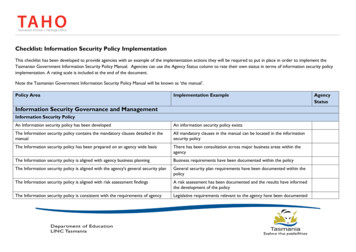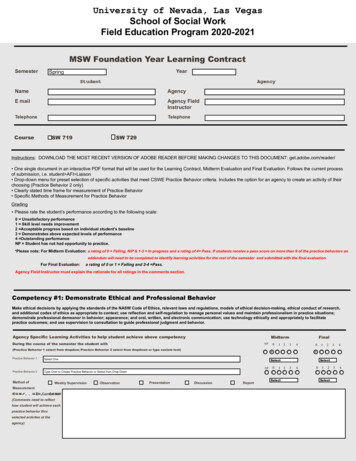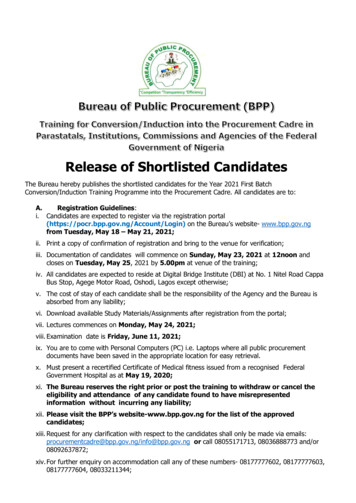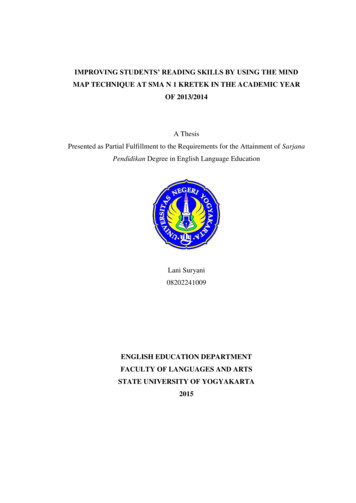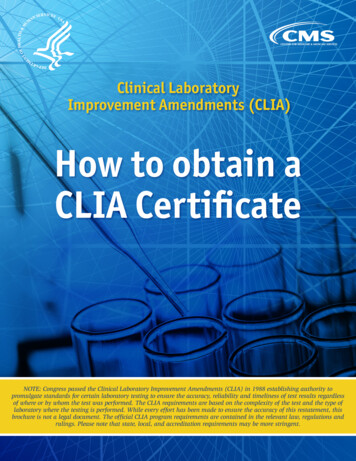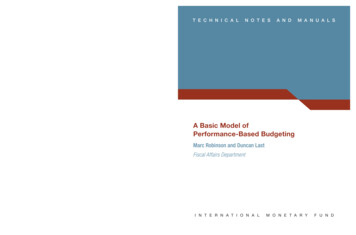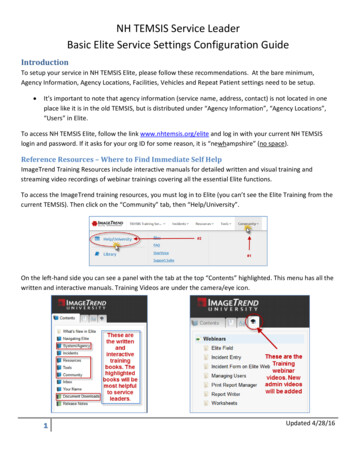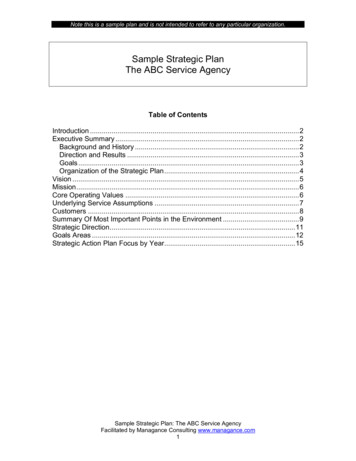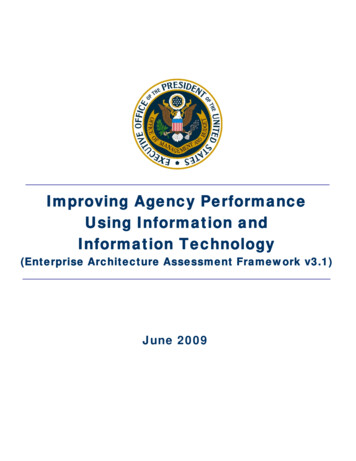
Transcription
Improving Agency PerformanceUsing Information andInformation Technology(Enterprise Architecture Assessment Framework v3.1)June 2009
Table of Contents1 INTRODUCTION. 12 PERFORMANCE IMPROVEMENT LIFECYCLE. 32.1 ARCHITECT .42.2 INVEST .52.3 IMPLEMENT .62.4 MEASURE, ASSESS AND IMPROVE .62.5 AGENCY SUBMISSION DATA QUALITY.73 FEDERAL ENTERPRISE ARCHITECTURE OVERVIEW . 83.1 FEA REFERENCE MODELS .83.2 SEGMENT ARCHITECTURE .93.3 FEDERAL TRANSITION FRAMEWORK.104 FRAMEWORK STRUCTURE . 124.1 CHANGES IN THE 3.1 FRAMEWORK .124.2 ASSESSMENT CRITERIA OVERVIEW .125 AGENCY EA ASSESSMENT SUBMISSION AND SCORING PROCESS. 155.1 EAAF VERSION 3.1 IMPLEMENTATION TIMING .155.2 AGENCY EA ASSESSMENT & REVIEW .166 ASSESSMENT FRAMEWORK 3.1 CRITERIA. 186.1 COMPLETION CAPABILITY AREA .186.1.1 Target Enterprise Architecture and Enterprise Transition Plan.196.1.2 Architectural Prioritization.216.1.3 Scope of Completion.226.1.4 Internet Protocol Version 6 (IPv6).246.2 USE CAPABILITY AREA .266.2.1 Performance Improvement Integration .266.2.2 CPIC Integration.286.2.3 FEA Reference Model and Exhibit 53 Data Quality .296.2.4 Collaboration and Reuse.316.2.5 EA Governance, Program Management, Change Management, and Deployment .336.3 RESULTS CAPABILITY AREA.366.3.1 Mission Performance .366.3.2 Cost Savings and Cost Avoidance .376.3.3 IT Infrastructure Portfolio Quality.396.3.4 Measuring EA Program Value .40APPENDIX A: ARTIFACT DESCRIPTIONS . A-1APPENDIX B: STRATEGY FOR MEASURING DATA QUALITY. B-1APPENDIX C: AGENCIES INCLUDED IN THE EA ASSESSMENT PROCESS . C-1June 2009
OMB EA Assessment Framework 3.11 IntroductionThe Federal Government is focused on delivering solutions and achieving resultsgrounded in the principles of transparency and open government. In the course ofmanaging the President’s budget, with over 70 billion in annual spending1, there is aninherent responsibility to manage information technology (IT) investments wisely. Thisinvestment, and in particular the 23.7 billion in Development, Modernization, andEnhancement (DME, BY2010) funding, represents a key resource for improving agencyperformance, closing performance gaps and achieving government-wide transformation.The Office of Management and Budget (OMB) Enterprise Architecture AssessmentFramework (EAAF) Version 3.1 identifies the measurement areas and criteria by whichagencies are expected to use the EA to drive performance improvements that result inthe following outcomes: Closing agency performance gaps identified via coordinated agency strategicplanning and performance management activities; Saving money and avoiding cost through collaboration and reuse, productivityenhancements, and elimination of redundancy; Strengthening the quality of agency investment portfolios by improving security,inter-operability, reliability, availability, solution development and service deliverytime, and overall end-user performance; Improving the quality, availability and sharing of data and informationgovernment-wide; and Increasing the transparency of government operations by increasing the capacityfor citizen participation and cross-governmental collaboration.While agencies have clearly demonstrated a degree of maturity and competency indeveloping and using their EAs, EAAF Version 3.1 seeks to advance the practice of EA,particularly through the development and use of agency segment architectures, aimedat driving the kinds of government-wide outcomes described above.EAAF Version 3.1 features the use of key performance indicators (KPIs) to measure theeffectiveness of EA relative to the three EA capabilities areas of Completion, Use, andResults. It also moves agency EA submission to a template-based model aimed atimproving reporting and assessment via an automated process and deliverymechanism. Artifacts will be posted on the MAX collaboration environment.EAAF Version 3.1 also changes the assessment and reporting process. Instead of asingle annual assessment, Version 3.1 moves to posting relevant artifacts for theCompletion, Use, and Results capability areas in order to better align the use of EA withagency planning, investment management, and budget formulation and decisionmaking processes relevant to the annual budget cycle.1 75,829M total, 23,686M in DME. This represents the IT crosscut across the President’s BY10Budget. Please see ml for more information.June 20091
OMB EA Assessment Framework 3.1The EAAF supports policy implementation and assessment when meeting the EA andrelated requirements set forth in OMB Circulars A-11 and A-130. EAAF Version 3.1 isclosely aligned with the methodologies, reporting templates, and tools such as theFederal Transition Framework (FTF), the Federal Segment Architecture Methodology(FSAM), and OMB’s IT Spending Dashboard.2Six key success factors for agencies with the EAAF v3.1 will be their ability to: Align with agency performance improvement to quantitatively plan for andsupport measurable delivery of agency performance improvement. Collaborate with other agencies to deliver common architectures for shared crossboundary mission, business, and technical requirements. Contribute to the definition and implementation of the target Federal EnterpriseArchitecture. Leverage bureau and program architecture activity to build out the agency EAand ensure that agency-proposed IT spending is well-architected, implementingthe target agency and Federal Enterprise Architecture, and demonstrably drivingagency performance improvement. Integrate with agency IT Governance to ensure effective use of the agency EA tosupport delivery of agency performance improvement. Through the above, establish buy-in with mission and business owners, andcomplete the evolution to results-focused architecture.OMB is committed to working with agencies through the annual assessment andquarterly reporting process to successfully implement the EAAF v3.1. For moreinformation on the quarterly reporting process, see Section 5 below.2Additional information on these tools and methodologies can be found at www.egov.gov , Note: ITSpending Dashboard was previously referred to as VUE-IT.June 20092
OMB EA Assessment Framework 3.12 Performance Improvement LifecycleGovernment agencies are continually assessing current performance, identifyingopportunities for performance improvement, and translating opportunities into specificactions. Enterprise architecture is an integrated management practice that maximizesthe contribution of an agency’s resources to achieve performance goals. Architecturedescribes clear line-of-sight from strategic goals and objectives, through investments, tomeasurable performance improvements for the entire enterprise or a portion (segment)of the enterprise.The focus of this document, and the discussion in this chapter, is information and ITenabled performance improvement.Agency EA programs are one of several practice areas that must be effectivelyexecuted to achieve improvements in agency mission performance and othermeasurement areas.3 EA helps to organize and clarify the relationships among agencystrategic goals, investments, business solutions, and measurable performanceimprovements - it is but one link in a chain of integrated practice areas. To achievetarget performance improvements, other practice areas such as strategic planning,capital planning and investment control (CPIC), and program and project management must be strong and fully integrated with an agency EA practice.Results-oriented architecture is developed within the context of the PerformanceImprovement Lifecycle. The Performance Improvement Lifecycle comprises threephases: “Architect”, “Invest”, and “Implement”. Each lifecycle phase is comprised oftightly integrated processes that combine to transform the agency’s top-down strategicgoals and bottom-up system needs into a logical series of work products designed tohelp the agency achieve strategic results. Through practice area integration, thePerformance Improvement Lifecycle provides the foundation for sound information andIT management practices, end-to-end governance of IT investments, and alignment ofIT investments with an agency’s strategic goals.The Performance Improvement Lifecycle defines a simple value chain linking enterprisearchitecture with IT investment management and program and project execution.Figure 2-1 below illustrates the logical integration and sequencing of key architecture,investment and implementation activities, as well as feedback from programassessment and performance measurement.3Other stakeholders, many of whom are the actual drivers and owners for program success, include theChief Financial Officer and Budget Officers, Chief Performance Officers, Chief Acquisition Officers,Congress, agency leadership, business owners, program managers, and the public.June 20093
OMB EA Assessment Framework 3.1InvestArchitectAgencyStrategyDevelop andmaintain PlanExecuteProjectsAgencyResultsMeasure, Assess, and ImproveFigure 2-1: Information and IT-Enabled Performance Improvement LifecycleContinuous performance improvement is the principal driver connecting EA programstaff with key business stakeholders across each phase of the PerformanceImprovement Lifecycle. Agency Chief Architects and EA program staff play importantroles supporting business stakeholders during each phase of the PerformanceImprovement Lifecycle to: identify and prioritize enterprise segments and opportunities to improve missionperformance, linked to agency goals and objectives; plan a course of action to close performance gaps, using common or sharedinformation assets and information technology assets; allocate agency resources supporting program management and projectexecution; measure and assess performance to verify and report results; and assess feedback on program performance to enhance architecture, investmentand implementation decisions.Opportunities to improve mission performance are prioritized in terms of their relativevalue to the agency’s strategic goals and objectives in the enterprise transition plan(ETP) and segment architecture. Prioritization underscores the importance ofconsidering cost savings and cost avoidance commitments and delivery in this step, aswell as year-over-year cost and schedule performance of IT investments. In particular,agencies should utilize feedback from performance measurement mechanisms toevaluate and adjust their prioritization of enterprise segments.2.1 ARCHITECTEnterprise architecture describes the current (baseline) and future (target) states of theagency, and the plan to transition from the current to the future state, with a focus onagency strategy, program performance improvements and information technologyinvestments. Agency EAs are organized by segments – core mission areas (e.g.,homeland security, health), business service (e.g., financial management, humanresources), and enterprise services (e.g., Information Sharing). Segments are definedusing the Federal Enterprise Architecture (FEA) reference models, described insubsequent chapters.June 20094
OMB EA Assessment Framework 3.1The purpose of the target enterprise architecture is to develop a set of blueprints, usingthe FEA reference models, that when implemented can effectively achieve the strategicgoals of an agency or agencies, The enterprise transition plan (ETP) identifies adesired set of business and IT capabilities, and highlights the performance milestonesthat need to be met along the path to achieving the target enterprise architecture. Italso defines logical dependencies between major activities (i.e. program/project,investment) and helps to define the relative priority and sequencing of those activities.This can be represented at the enterprise level or across segments within the EA.Agencies should prioritize segments within the EA using performance improvementopportunities captured in the enterprise-wide performance architecture. Theprioritization process should also consider further opportunities to increase costeffectiveness in service delivery, to enhance IT portfolio quality, or to improve thequality, validity, and timeliness of mission performance and cost accounting metrics.To achieve the target performance improvements, the agency EA should fully integratewith the capital planning and investment control (CPIC) step, as well as the agencysystem (solution) development life cycle (SDLC). OMB Circular A-130 states:“Agencies must establish and maintain a capital planning and investment controlprocess that links mission needs, information, and information technology in an effectiveand efficient manner. The process will guide both strategic and operational IRM, ITplanning, and the enterprise architecture by integrating the agency's IRM plans,strategic and performance plans, financial management plans and the agency's budgetformulation and execution processes ”The FEA Practice Guidance4, provides more information on techniques and bestpractices for EA Practice Integration.2.2 INVESTPerformance improvement opportunities identified during the “Architect” process areideally addressed through an agency portfolio of IT investments5. This step defines theimplementation and funding strategy for individual initiatives identified in the EnterpriseTransition Plan (ETP) and described in the segment architectures. Programmanagement plans are created to implement the individual solutions identified in theimplementation and funding strategy.Agency investment proposals captured in the agency’s Exhibit 53 and portfolio ofExhibit 300s need to be aligned with the agency EA. To show alignment with theagency EA and transition plan, the Exhibit 300s and Exhibit 53 line items for eachinvestment are mapped to the Federal Enterprise Architecture (FEA) Reference Modelsand agency-defined segment architectures. This creates a linkage from agencystrategy to EA to segment architecture to IT investment, thus ensuring resources areutilized to support the strategic objectives of the /fea docs/FEA Practice Guidance Nov 2007.pdfIt is recognized that, more often than not, funding is provided by Congress in advance of programdesign or the development of an architecture.5June 20095
OMB EA Assessment Framework 3.1During this step of the Performance Improvement Lifecycle, agencies should carefullyevaluate and adjust their prioritization to ensure investments are aligned, via highpriority segments, to agency strategic goals and objectives. Further, the prioritizationshould be refined to reflect additional opportunities for cost savings and avoidance, aswell as other approaches to improve agency performance. Agencies should alsoincorporate high priority national objectives identified as part of the FTF within its EAand investment portfolio.The FEA Practice Guidance provides more information on techniques and bestpractices to align agency enterprise architecture and investments.2.3 IMPLEMENTProjects are executed and tracked throughout the system development life cycle(SDLC). Achievement of the program / project plan within acceptable variance forschedule and budget is measured and reported through Earned Value Management(EVM) process. Performance is measured to determine how well the implementedsolutions achieve the desired (process) outputs and mission outcomes, and providefeedback into the enterprise and segment architecture development processes as wellas the cyclical strategic planning process.2.4 MEASURE, ASSESS AND IMPROVEInformation and information technology, as critical enablers of program performanceimprovements, must be assessed and evaluated in the context of agency missions andoutcome-oriented results defined in the enterprise-wide performance architecture.Performance improvement plans and priorities, including those previously gatheredunder the PART and Performance Assessment Report (PAR) programs, should bereflected in the agency EA, particularly the performance architecture and ETP.Performance metrics previously gathered under the PART Program are used toevaluate agency program performance and results in agency performance improvementplans, identifying a program’s strengths and weaknesses and addressing ways toimprove the program performance. PAR metrics and measures provide specificinformation on agency mission performance, and often monitor and regulate agencystrategy.The FEA Practice Guidance6 provides more information on techniques and bestpractices to align the agency ETP and performance measures and outcomes.For segment architecture development, the EA Segment Reporting v1.2 guidanceprovides an explanation of using performance data from the PAR, PART, and Exhibit300s to inform segment level performance measures and metrics. Invariably,transformation at the enterprise level, cannot occur without the measured performanceimprovements and outcomes demonstrated within each of the segments.6http://www.whitehouse.gov/omb/assets/fea docs/FEA Practice Guidance Nov 2007.pdf.June 20096
OMB EA Assessment Framework 3.12.5AGENCY SUBMISSION DATA QUALITYOMB collects a significant amount of IT investment data and other related data fromexecutive agencies during each phase of Performance Improvement Lifecycle. OMBofficials use this information to guide the development of an efficient and effective ITinvestment portfolio as a part of the President’s budget request to Congress.Within OMB, the Office of E-Government and Information Technology considers avariety of different data sources and inputs in the analysis of proposed IT investments.These data sources include but are not limited to: Agency EA submissions, plans, and milestonesAgency-submitted IT investment portfolio (Exhibit 53)Investment business cases (Exhibit 300)Prior year agency IT budgetReports from the General Accounting Office and Inspector GeneralProgram oversight data including earned-value management and other reportsAgency management commitments and resultsThis data helps OMB decision-makers select IT initiatives and investments that promiseto deliver the highest value and performance impact for the Federal Government withina constrained budgetary environment. In order to make informed decisions, OMB isdependent upon agencies to provide high-quality data submissions. EAAF Version 3.1outlines expectations for high quality submissions through transparency on KPIs andassociated algorithms and heuristics.Appendix B describes OMB’s strategy for using the KPIs defined within the EAAFVersion 3.1 to enforce high standards of data quality for agency EA and IT investmentportfolio submissions.June 20097
OMB EA Assessment Framework 3.13 Federal Enterprise Architecture OverviewThe Federal Enterprise Architecture is a business-based framework used by FederalChief Information Officers (CIOs) to develop IT investment portfolios aligned to theiragency’s business functions and processes and cross-agency needs. The FederalEnterprise Architecture provides several discrete artifacts including: The FEA Reference Models; The Federal Transition Framework (FTF)7; and An Assessment Instrument (OMB EA Assessment Framework).OMB Circular A-118 sections 53 and 300 require Federal agencies to align their ITinvestments to the FEA Reference Models and segment architecture. EAAF Version3.1 is designed to assess agency responses to this policy and gauge the extentagencies are using their EA and ETP to implement cross-agency initiatives and achievemeasurable performance improvements.3.1FEA REFERENCE MODELSThe FEA Reference models include the Performance Reference Model (PRM); theBusiness Reference Model (BRM); the Service Component Reference Model (SRM);the Data Reference Model (DRM); and the Technical Reference Model (TRM).Together, these models comprise the FEA Consolidated Reference Model (CRM) asillustrated in Figure 3-1.Business-Driven Approach Inputs, outputs, and outcomes Uniquely tailored performance indicatorsBusiness Reference Model (BRM) Lines of Business Agencies, customers, partnersService Component Reference Model (SRM) Service domains, service types Business and service componentsData Reference Model (DRM) Business-focused data standardization Cross-agency information exchangesTechnical Reference Model (TRM)Component-Based ArchitecturePerformance Reference Model (PRM) Service component interfaces, interoperability Technologies, recommendationsFigure 3-1: FEA Reference tp://www.whitehouse.gov/omb/circulars/a11/current year/a11 toc.htmlJune 20098
OMB EA Assessment Framework 3.1The Performance Reference Model (PRM) provides a framework to use EA tomeasure the success of IT investments and their corresponding impact on strategicoutcomes. This model links internal business components to the achievement ofbusiness and customer-centric outputs.The Business Reference Model (BRM) provides a comprehensive blueprint of thefederal government around common business models. By focusing on commonbusiness models spanning multiple agencies, it promotes agency collaboration andfacilitates the alignment of business functions with common FEA solutions and E-Govstrategies.The Service Component Reference Model (SRM) classifies service componentsaccording to their support for business and performance objectives. This modelimproves efficiency by exposing opportunities for the reuse of business componentsand services to support business functions across the Federal Government.The Data Reference Model (DRM) enables information sharing and reuse across theFederal Government through the standard description and discovery of common dataand the promotion of uniform data management practices. This model providesguidance on the implementation of consistent processes to enable data sharing throughFederal Government-wide agreements.The Technical Reference Model (TRM) categorizes standards and technologies toenable the delivery of service components and capabilities. This model provides afoundation to advance reuse and technology standardization from a government-wideperspective. It allows agencies to realize economies of scale by identifying and reusingthe best solutions and technologies to support their mission and business functions.3.2SEGMENT ARCHITECTUREEnterprise segments are subsets of the overall agency enterprise architecture, describingcore mission areas (e.g., homeland security, health), business services (e.g. financialmanagement), or cross-cutting enterprise services (e.g. Information Sharing). Core missionand business service segments are aligned with the FEA BRM and enterprise servicesegments are aligned with the SRM.Agency Enterprise Architects define enterprise segments as a component of their EAplanning activities. Segments are classified as one of the three fundamental segmenttypes (core business, business service, enterprise service). In turn, investmentssupporting a given segment reflect the target segment architecture and are aligned withthe agency enterprise architecture.Agencies should use their strategic goals and objectives, EA and ETP as the basis foridentifying and prioritizing enterprise segments. The process to identify and prioritizeenterprise segments should reflect the following key characteristics: Use performance gaps, identified by the agency’s strategic plan, IG or GAO reports,and/or performance improvement assessments, as the driver for segmentidentification and prioritization;June 20099
OMB EA Assessment Framework 3.1 Identify new requirements and opportunities within the agency strategic plan anduse these new requirements to expand existing segments or develop newsegments;Integrate cross-agency initiatives using the FTF described below; andMeasure the value of and results from enterprise architecture to stakeholders.Cross-agency teams, chartered by the Federal CIO Council, are working with OMB todevelop step-by-step step guidance documents serving as a road map for architectsdeveloping segment architecture.3.3FEDERAL TRANSITION FRAMEWORKThe Federal Transition Framework (FTF)9 provides agencies with information on how toalign their enterprise architecture and segment architecture to various policy-drivencross-agency information technology (IT) initiatives using a simple and familiarstructure. The FTF contains a catalog of cross-agency initiatives in a format easilyincorporated and is comprised of sections corresponding to specific cross-agencyinitiatives. Each initiative is described using a standard structure including layerscorresponding to the five FEA reference models.Agencies should use their Enterprise Transition Plan (ETP) and segment architecturesto align and integrate appropriate cross-agency initiatives from the FTF with theirenterprise architecture10. Relevant cross-agency initiatives are reflected in agency ITinvestment portfolios (Exhibit 53) and business cases (Exhibit 300s). Segmentarchitectures provide the integration point between cross-agency initiatives,performance improvement goals, and agency improvement commitments, as illustratedbelow in Figure 3-2. The FEA Practice Guidance and Federal Segment ArchitectureMethodology (FSAM) provide additional information on segment architecture and e burden of proof lies with the agency whenever that agency includes architectural segments that areidentical OR similar to initiatives that are included in the FTF. For example: Since there is a governmentwide financial management initiative identified in the FTF, any agency that proposes a new financialmanagement effort that does not reuse, share, or comport with the FTF initiative must provide writtenjustification on why that agency’s requirements are so divergent from the FTF financial managementinitiative as to warrant separate development and funding. For the most part, if a service componentexists within the FTF, agencies are required to consider reuse or share services, and replicate thearchitectural segment from the FTF, including the Lines of Business.10June 200910
OMB EA Assessment Framework 3.1Enterprise Transition Plan12345Program jectProjectSegmentArchitectureProgram C6789Program provementSummaryInterimTarget 1InterimTarget 2Target EA with SegmentsLine of BusinessSegment rent EA “Baseline”Program AMajor IT InvestmentsExhibit 53(All IT Investments)Exhibit 30053 Line ItemExhibi
Enterprise architecture describes the current (baseline) and future (target) states of the agency, and the plan to transition from the current to the future state, with a focus on agency strategy, program performance improvements and information technology investments. Agency EAs are organized by segments - core mission areas (e.g.,
